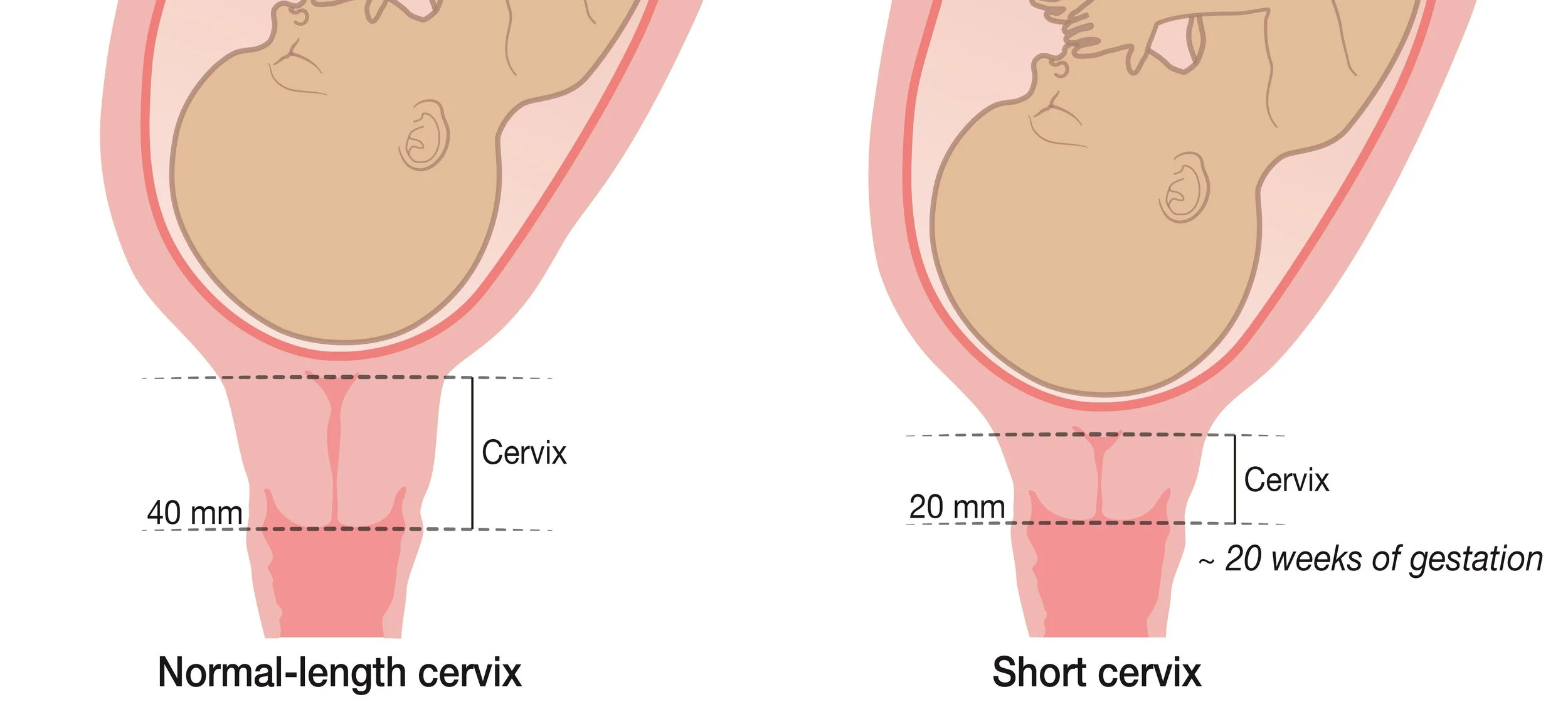
Short Cervix
One of the best ways your healthcare professional can predict if you will have a preterm birth is by measuring the length of your cervix. If you have a short cervix, steps can be taken to help prevent preterm birth in your current pregnancy.
-
The cervix is a tube that connects the bottom of the uterus to the top of the vagina. The distance between these two points is the cervical length. This measurement differs from cervical dilation, which is how much the cervix opens in labor. A short cervix is diagnosed when the cervix measures less than or equal to 25 mm, which is about 1 inch.
-
Actually, all pregnant people are at risk of having a short cervix. But some of the factors that make a short cervix more likely include:
Previous procedures on the cervix, such as a cone biopsy or laser removal of tissue for abnormal cells
Previous preterm birth
History of tearing of the cervix during a previous delivery
Previous dilation and curettage
-
Having a short cervix increases the risk of having a preterm birth (before 37 weeks of pregnancy). Preterm babies are at risk of complications, including neonatal intensive care unit (NICU) admission, difficulty breathing, low birth weight, low blood sugar, and other health issues. Preterm birth is the number one cause of newborn health problems and deaths in the United States today.
-
All pregnant people should have a cervical length measurement during the anatomy scan ultrasound, usually between 18 and 22 weeks. The cervix can sometimes be seen by abdominal ultrasound. In some cases, a transvaginal ultrasound may be needed. In this type of ultrasound, a narrow probe is placed in the vagina. A transvaginal ultrasound does not harm the fetus or cause problems with the pregnancy.
-
If you are less than 24 weeks with a single fetus, have no history of preterm birth, and are found to have a short cervix, your healthcare professional may discuss starting vaginal progesterone. This medication is a cream, gel, or a pill that you place in the vagina. Several studies have shown that vaginal progesterone may help reduce the risk of preterm birth in pregnant people with a short cervix without a history of preterm birth.
-
If you previously gave birth before 37 weeks, frequent ultrasound monitoring of your cervical length between 16 and 24 weeks of pregnancy may be recommended. This recommendation does not apply if you had to deliver your baby early due to a medical reason. You and your healthcare professional may discuss vaginal progesterone or cervical cerclage. A cerclage is a stitch that is placed in the cervix to help prevent preterm birth.
-
The risk of preterm birth is higher with twin pregnancies. In most cases, vaginal progesterone or cerclage are not routinely recommended in twin pregnancies with a short cervix. More research is needed to find treatments that prevent preterm birth in these pregnancies.
Quick Facts
A short cervix is identified when the cervical length is less than or equal to 25 millimeters on an ultrasound. Having a short cervix increases the risk of preterm birth.
Diagnosing a short cervix involves measuring the cervical length during a second-trimester ultrasound. Sometimes, a transvaginal ultrasound may be needed for an accurate measurement.
For patients pregnant with a single fetus and no prior history of preterm birth who are diagnosed with a short cervix, vaginal progesterone may be recommended. This medication may help prevent preterm birth in the current pregnancy.
Vaginal progesterone may also be recommended for pregnant people with a prior preterm birth and a short cervix. A procedure called cerclage may also be recommended.
Glossary
Abdominal ultrasound: An ultrasound exam performed with a probe (also called a transducer) moved over the abdomen.
Cerclage: A procedure in which a stitch is placed around the cervix to prevent or delay preterm birth. It may be offered in certain situations based on a number of different factors.
Cervix: The opening to the uterus located at the top of the vagina.
Dilation: The gradual opening of the cervix during labor to allow the baby to pass through the birth canal.
Neonatal intensive care unit (NICU): A special unit in the hospital that cares for sick newborns.
Preterm birth: Delivery of a baby before 37 weeks of pregnancy.
Progesterone: A hormone that regulates the menstrual cycle and plays a role in pregnancy. It is also used as a medication.
Transvaginal ultrasound: An ultrasound exam performed with a narrow probe inserted into the vagina.
Ultrasound: Use of sound waves to create images of internal organs or the fetus during pregnancy.
Last Updated: March 2025

